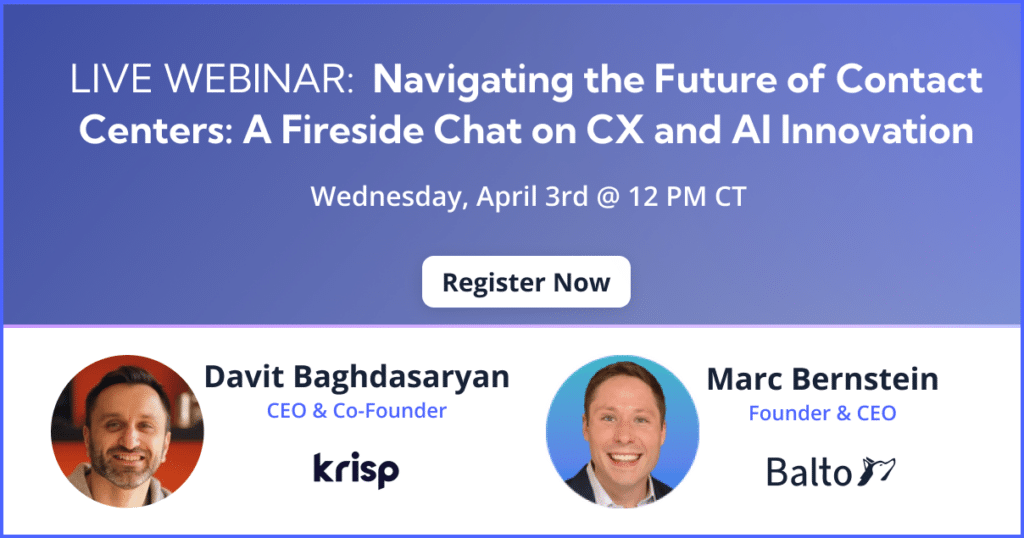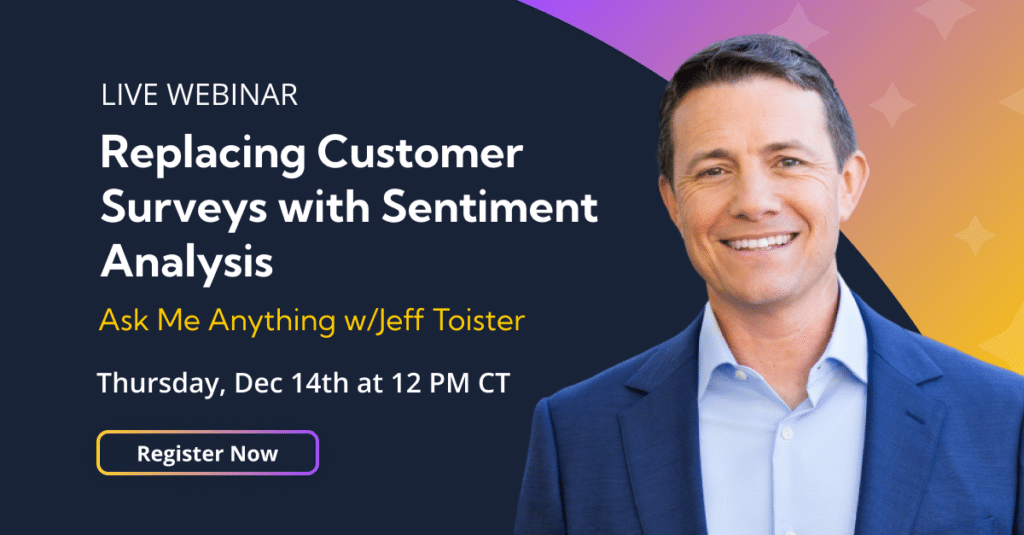How Creditors Bureau USA boosts win rates and agent experience with Balto’s Real-Time Guidance
“They say a dog is a man’s best friend, but I think Balto is a collector’s best friend.” – Kasey Ismail, Collections Team Lead at Creditors Bureau USA
Achieving high agent engagement in your contact center is essential not just for maintaining high job satisfaction and employee retention, but ultimately for maximizing revenue and customer satisfaction. In this webinar, Kasey Ismail speaks on how his collections team has massively improved agent effectiveness, achieved near-perfect compliance adherence, and boosted win rates and the number of successful calls by utilizing real-time guidance and focusing on team buy-in and positive agent experience.
Stephen McDonnell:
All right. It is the top of the hour. I know everyone is very busy, so I will get right to it, and we’ll get started. Welcome, everybody. And thank you for joining, our webinar today. Today we’re gonna be discussing how to create superstar reps and improve agent engagement. We’re gonna hear from my good friend, Kasey from Creditors Bureau USA. We’re gonna learn about how his team and he have worked with, his crew to boost, win rates, increase agent experience, and just ultimately make the workplace better overall for his company using Balto’s Real-Time Guidance.
Stephen McDonnell:
To introduce myself, I’m Stephen McDonnell, I’m a Customer Success Manager here at Balto and I’m gonna be the host for today’s webinar.
Before we get started, just a couple of housekeeping details. The session gonna be about 30 minutes with Q&A at the end. So come with any questions prepared at the end feel free to submit them as you have them throughout the presentation, there’s a Q&A button on your screen. It should be at the bottom and you can use that to submit them, and then we’ll see them all as they come in. Everyone who registered for today’s webinar will also receive a follow-up email with links to access the video recording in presentation slides from the broadcast. So if there’s anything that you miss or anything that you wanna revisit, you’ll be able to do that.
Now I’m gonna show you our agenda for today. Briefly, we’re gonna talk and define the elements of what is agent engagement, then Kasey is gonna share about how the Creditors Bureau has used Balto to drive results and really support his collections team using the idea of agent engagement and really getting them involved. And then we’ll share and discuss a few tips to help your team improve agent engagement and performance and just to improve the day-to-day life.
Stephen McDonnell:
Without further ado, I’m gonna introduce Kasey, my good friend. He is our webinar guest for today, joining us from Creditors Bureau USA to talk about his team’s success and how they’ve used Balto to support their agents. So welcome, Kasey, thank you for joining us today. We appreciate your time. First, can you introduce yourself and share a little bit about yourself and the Creditors Bureau?
Kasey Ismail:
Yeah, of course. Thanks, Stephen. My name is Kasey and I’ve been with Creditors Bureau USA for over five years. CBU mostly deals with medical collections, and we have a team of around 30 collectors. I am the collections team leader and trainer. I help onboard new employees and help current ones be more successful.
Stephen McDonnell:
Awesome. Thank you, Kasey. Before we dive in and hear more about the Creditors Bureau and Kasey’s team I just wanna give a quick background, define what we’re describing as agent engagement and make sure that we have a clear idea of what we’re talking about and what we’re referring to when we say agent engagement.
We’ll be focusing on agent engagement as active interest, involvement, enthusiasm, motivation, and commitment to agents’ daily work. As well as a high level of connection, the organization, and active participation in the success of the team. As we continue today, keep in mind these elements of contact center success listed on the right-hand side of the screen-positive experience, job satisfaction, higher retention, low turnover, increased skill and knowledge, and improved performance over time, and how they continue at cyclical. They’re gonna continue to improve and build upon each other. What we’ve seen is that success in these areas relates back to high agent engagement. The more agents are engaged, the higher retention, lower turnover, increased scale level, et cetera. It ultimately just forms that, that positive cycle for your team.
Kasey, I wanna throw it to you. How have you seen these elements of agent engagement impact your team and your team’s success?
Kasey Ismail:
Yeah, absolutely, Stephen. The Balto checklist running live during a call pushes agents to be more motivated to check off the important things they have to say to consumers as well as to stay in compliance. As far as a connection Balto helps us stay active and participate in the team’s success by following procedures easily because they’re readily available on Balto. For example, if we have to talk to an attorney, we can scroll down and see what the best things are to say to get the best information instead of like memorizing every line, Balto has us covered basically from A to Z.
Stephen McDonnell:
Awesome. excellent. Now that we’ve, we’ve talked about the elements of agent engagement and how important they are to contact center success. We’ll hear more about Kasey and his experience with the Creditors Bureau USA and being able to achieve success in these areas.
So first Kasey, could you share a bit about the challenges and issues that your team was experiencing before you started using Balto and what you’ve done to manage collectors pre-Balto. What was going on, and what were the challenges you faced?
Kasey Ismail:
I’d love to share that. When I was hired at Creditors Bureau USA, I can remember I had papers spread out on my desk and rummaging through them while making calls. I used to heavily rely on those papers and the scripts to have a successful call. Eventually, I memorized the script and I was able to do my job a little easier. Yet, there was still something I would struggle with often. I would struggle with remembering if I’ve already started something. I would think to myself, “Did I say that already?” I hated not knowing a hundred percent if I had started something. I learned to be more confident in my job and the statements I was making, but the issue never really went away until I was introduced to Balto. When we first started using Balto, it was life-changing.
Finally, there was some relief during my phone calls for someone like me, who was a visual learner. Balto changed my whole perspective and made me feel even more confident when speaking to consumers. In short, I was able to do my job better. My fears of being unsure if I had stated something basically dissipated because Balto lit up every time I had made one of those statements. I started to look forward to making my statements or completing the checklist and seeing everything light up, turning green. It was even more enjoyable getting payments because there would be confetti flying everywhere on my screen. Basically, Balto congratulated me on getting that payment. They say a dog is a man’s best friend, but I think Balto is a collector’s best friend.
Stephen McDonnell:
I love it. What a quote. Thank you for sharing that Kasey. Before we get into some more details and specifics of how you really achieved these great results, I want to briefly go over how Balto works and how Real-Time Guidance is used to help support and guide agents live on calls. The Balto agent app sits on the agent screen, next to whatever they’re working on, and uses the best in class voice recognition in AI to automatically listen to, and analyze both sides of the call audio. Balto essentially follows along with the conversation and is gonna be displaying smart checklists, and dynamic prompts, as you can see in the visual there, to automatically guide agents to use top-performing call flows, asking discovery questions, getting over objections with rebuttals, and using responses. Making sure that they’re saying the right thing at the right moment on every call.
So really is a man’s best friend. It sits there and helps the agents really focus on the content of the call and not have to worry about “ Oh, did I say this already?”, “ Oh, what if they say this?”, “How do I respond? ”
Here on the right side of the screen, as I pointed out is an example of a prospect who indicates that they have budget limitations. Balto recognizes that objection when it hears it and automatically provides proven high-performing responses to the agent. Once the agent uses one of those requests, Balto hears it, automatically checks it off, and then continues to guide the conversation. And then you’ll be able to see on the reporting end, which of those responses is leading to success and you can continue to improve what Balto is hearing, what is suggesting for agents, and so on.
Now that we have a basic idea of how Balto works and how it supports agents I wanted to share a couple more quotes that you, Kasey, shared with me from your collectors. We actually absolutely love I’d love if you could speak a little bit to them.
Kasey Ismail:
Oh yeah, absolutely. Basically, we have a newer agent, but he was with a different collection agency before. He had Balto before at that previous agency, came over here and we had Balto as well. He was just happy to have it again and be able to work with it again. He says Balto exceeds his expectations and helps him get through calls faster instead of using a paper script, and looking for the right things to say. Whoever built the amazing program put time and thought into how it will work and kind he enjoys having it like a little dog app. It’s a good pet.
The other agent, she was with us for a few years and she had some children came back to have Balto here and has had a lot of success, and it’s been helping her do her job a little better. So it says, Balto provides a wonderful tool to help us stay focused on the call and gives us information on how to handle accounts. What else I like about is that it goes through an important list and details what we’re supposed to say. I wish I had this years ago is the end of her quote.
Stephen McDonnell:
I love that. And I think that’s important to note too, cause I think the benefits with new agents are really easy to see immediately. But to know that agents who are more tenured and have been in the collection space for longer, like yourself and like this agent, it’s great to hear that Balto is still helping out.
Now we’re gonna go over some tips and hear about your experience. It’s great to hear all about Balto and how it’s helped you, but what exactly have you done with your group to really implement agent engagement, and how has Balto helped do that? So I’m going to go over a few different topics, that you’ve brought up of how it’s improved results and helped give you a higher engagement.
Our first tip is to ask your agents what works best and involve your team in the process of improving, optimizing, and refining your call content essentially. So you’ll identify best practices and you’ll also create a powerful, positive feedback loop to continuously improve what you’re getting from agents because they’re the ones on the phones every day. They’re the ones that are hearing what’s trending. It gives them that sense of ownership where they can come to you and say “Hey, here’s like what we’re hearing on the calls. How can we have Balto come in here and essentially help us improve our experience? “
On that note, can you describe a little bit about how your team seeks input and feedback from agents to make improvements over time? And how has this process helped really improve engagement and performance for your team?
Kasey Ismail:
Yeah. So for one Balto is great because it helps tremendously when onboarding new employees instead of having to print that paper as the main resource, the trainees can look easily to Balto on their screen to help them remember what they’re required to say to have a successful call. Instead of our agent reaching out to management they can easily check Balto first for resources to help them on certain calls. What we found very helpful is using that “CONTROL S” on the keyboard which actually starts running Balto before an agent makes their first real call to a consumer. They can see how Balto operates and how it turns green when something is said. This process is awesome because it simulates how a real call will look and the real-time help that agents have available to them when they do start making the calls.
Stephen McDonnell:
That makes a lot of sense. I love that. Moving on to kind of the next step of that is scaling best practices. I’d love to hear about how you’ve done that. I know it’s always great to be successful in using your team to do that and figure out what works best on calls. You can really boost the team performance based on what you’re getting from different sides of individual agents. And it helps with job satisfaction by helping every member of the team implement these conversations and call flow in a convenient and flexible way.
How have you seen performance and results improve by using Balto? And can you share an example or two of a change that Balto has helped you implement that has led to better performance for your team as a whole?
Kasey Ismail:
Well, now I’m able to look up compliments and give a lot of positive reinforcement to the agents. I can manage the team even better now. I apply certain components to my KPI spreadsheets, like for example, Balto checklist usage, a collector’s wins, and their win rates. From average call handle time to total calls over one minute. These are things that I can look at to definitely help the agents in their success and successful calls. I think for almost any caller situation, Balto has a solution like how a real dog’s loyalty to its owner. For example, we have a whole section on possible call traps, whether it’s a question from a consumer on “How will this affect my credit?” to “ I won’t want to be recorded!” Balto can effectively help bail out a collector if they’re stuck on a response.
Stephen McDonnell:
That actually brings up a good point that I wanna ask about as well. When it comes to an ever-changing industry where there are certain compliance pieces of a call that has to be said and certain things that need to happen that change over time. What, historically, was your way of retraining agents as those changes have happened? How has that changed and how have you been able to scale that just in your company?
Kasey Ismail:
Absolutely. For example, we can refine the Balto checklist for new stuff like regulation F. We’re continually adjusting to meet that compliance. There are always changes in the industry, right? It’s so easy to adjust the Balto program to help our agents follow along with those changes, either in the industry or company procedures. Again, regulation F in response to the consent to call back within seven days, we have collectors that give us suggestions, maybe we should put “if needed” before that question. So “If needed, do we have your consent to call you back within the next seven days?”, if they ask us why, an agent has given us a suggestion to say, “for any follow-ups.” We’re able to refine and make it a lot better as time goes on and the changes happen.
Stephen McDonnell:
Awesome. I now want to talk about the next tip that we’ve talked about, which I think is awesome. I think this is something that is really important to all industries, and I think can be replicated anywhere and that’s recognizing high performers and really encouraging positive behavior, rather than, or in addition to, I should say, coaching negative behaviors. So identifying, recognizing, and rewarding high performers. I just love to hear, I know we’ve talked about your example. You have the superstar shoutouts that you do and would love to hear how you recognize the top performers on your team.
Kasey Ismail:
Yeah, absolutely. The superstar shoutouts are great. I basically pick an agent with outstanding numbers, like, you know, high checklist completion, wins, and compliments. In our weekly meetings with all the collectors, I give that agent praise and then I ask them how they did so well. It just really empowers the agent. It opens the floor for more questions from other agents. I pull the data from Balto easily, and that helps recognition for the best performers on my team.
Stephen McDonnell:
And now just Balto aside for a second, what have you found in terms of success with that positive feedback loop with agents? What differences have you seen in behavior, both of new agents, tenured agents, and everyone in between?
Kasey Ismail:
I feel like I get fewer supervisor calls transferred to me because the agents are able to use it as a resource and overcome stalls and objections. It’s basically like the number one tool. It’s just great. As far as the agents giving me any feedback, it’s always positive. I’m able to see agents excel while using this and just have more success on calls.
Stephen McDonnell:
Awesome. That makes a lot of sense. In terms of your superstar shoutouts, what have you seen in terms of any sort of changes in morale or boosts across the team? Has it become almost like it’s a fun name, so I imagine it is a fun event. How has that continued to improve the workplace as a whole?
Kasey Ismail:
Yeah, I think it boosts morale, especially during the meetings. I think everyone can relate to this, sometimes zoom meetings get a little boring, so it just adds that really good positive element to our meetings. And it boosts morale across the board for everyone. It’s kind of exciting to jump in the meeting now to see who’s going to get the shout-out, what they did, and the great feedback that they have to give regarding the numbers that I’m talking about and, and why they’re the superstar.
Stephen McDonnell:
When you’re focusing on, those positive reinforcement moments, have you seen any change in how agents take the constructive criticisms in the coaching moments?
Kasey Ismail:
They’re very receptive now. It’s easy to coach them on certain things. I would say they’re really receptive and it’s just a good way to coach someone by having that positive reinforcement. If the whole vibe of the zoom meeting is kind of negative and what people are doing wrong, they’re not so receptive, not so engaging, and they just don’t look as happy. Implementing the compliments that I can pull from Balto is amazing. I just send them their compliments even throughout the week, showing them besides the superstar shoutout, I’ll just send them their compliments during the week. And I feel like it makes them a little happier and in a better mood most of the time.
Stephen McDonnell:
Sweet. I agree, I’m glad that that’s how that’s working. Because I think that it’s part of that loop, the more that they’re encouraged and are being celebrated for their wins, it makes those coaching moments and those constructive criticism moments a lot easier to swallow and helps level the good and the bad.
We finally wanna talk about our final tip, which is providing the necessary resources and tools. Kasey, how has Balto helped you provide the necessary support resources tools for your collectors, and how has having access to these tools really helped your team perform their jobs better?
Kasey Ismail:
Yeah, the most important aspect I think in this industry is compliance. I think without Balto, we would have more issues with compliance because agents would forget to say things without it. Naturally, it’s helped us perform our jobs better by staying in compliance so well.
Stephen McDonnell:
Absolutely. Anything else that you wanted to talk about on this point before we keep moving on? But, I agree. I think that having those tools readily available for agents is gonna inherently improve performance and comfortability.
Kasey Ismail:
Absolutely. Going into a little more depth on this. We were eventually able to set up different checklists for inbound and outbound calls because it’s kind of a different experience, inbound versus outbound calls, right? People that are calling inbound might want to pay, but they’ll be able to give us more information right off the bat. In outbound calls, people don’t want to verify things right off the bat. We were eventually able to differentiate when a call comes in, is it an inbound list or should it be an outbound list? So not only did we create a concrete list for each, but we also included areas to assist the collectors in real-time. For example, if there’s an insurance stall, either Balto would pop up a deck item, giving suggestions, or the collector could scroll down and choose the call model they needed help with. We added all sorts of call models, ranging from workers’ compensation calls to personal injury calls with attorneys. It seems as if, no matter what the situation is Balto is prepared to help. It’s just amazing.
Stephen McDonnell:
Great, awesome. That is super helpful, Kasey. I appreciate that information. Thank you for being just so fantastic today. It’s been really helpful and I think that there are a lot of things to learn like really little tidbits that I think really improve that engagement in keeping that loop continuously going and snowballing in a positive way.
Next up, we’re gonna have a Q&A, so hang tight, Kasey. But first, we wanted to quickly tell you a little bit more about Balto and give you a chance to connect with us if you want to schedule a demo or get any information from our team. As we mentioned, Balto’s Real-Time Guidance helps keep agents on track and guides them through make-it or break-it moments on the call.
In addition to Real-Time Guidance, Balto also helps managers improve team performance with our Real-Time Quality Assurance and Real-Time Coaching solutions. Balto’s Real-Time QA automatically listens to and scores a hundred percent of calls in real-time. So you can quickly get a complete picture of call quality as a whole and on an agent-to-agent basis and then identify and fix the root causes before they become habits. With Real-Time Coaching automatically notifies managers of key moments in coaching opportunities in real-time during the call. And it allows managers to really jump in to see what caused the alert and then chat with the agent or listen on the call to immediately help impact the outcome of what’s going on live before it’s too late.
It’s proactive versus reactive coaching. As Kasey mentioned earlier Balto helps support agents to be more successful and ultimately make their jobs easier. We’ve seen this reflected in tons and tons of positive reviews shared by agents online including these five-star reviews here. Balto spiel out of the way. If you’d like to learn about Balto and schedule a demo, we encourage you to visit balto.ai and connect to see how Balto can really help and impact your team. You can also click the link that’s been shared in the chat, to schedule a demo with a member of our team.
Now, I’d love to go into some Q&A. It looks like we’ve received some great questions, so we’ll go ahead and jump in. Kasey, what KPIs do you see affected or improved by using Balto?
Kasey Ismail:
That’s a really good question. As far as the KPIs, I think that the average call handle is great to use on that. Because I can see if a collector is using a little more time on the calls – why is their average call time seven or eight minutes? Why is this other agent’s average call time two to three minutes? Are you spending enough time on the call? Are you spending too much time on the call? That’s kind of one thing I look at. Another thing is actually how many compliments someone’s getting. I can put that whole number in my spreadsheet and see, “Hey, this collector is getting 10 more compliments than this other collector.” Why? You know, and then I can look into stuff like that.
The Balto checklist completion: say they’re completing 40% of their checklist on average, I throw that in the KPIs as well. It just helps me to have more content to measure things. And when I do the superstar shoutouts, I look at how many compliments people get. I look at what their checklists completion rate is. And on top of all that I can see the wins. When we’re letting someone know what this will appear as on their bank statement, that counts as a win because we obviously have got a payment already. I look at people’s wins and their win rates and it just helps me to have a little more stuff on my KPIs that I can go and measure and see what this agent is doing versus this other agent.
Stephen McDonnell:
That makes a lot of sense. And, have you seen increases in your compliance rates with agents having Balto sitting right there on their screen?
Kasey Ismail:
100%. I mean, it’s right there. It’s like a reminder as well. I just feel like I haven’t had many issues with compliance, if there is an issue it’s kind of just one person, maybe they forgot this one time, but no it’s way different than it was before. I think that we’re able to kind of see the numbers a little bit easier and keep track of the compliance as well. So I do think it’s definitely gone down a lot. I think I mentioned this earlier, as far as complaints or supervisor calls. I get a lot less supervisor calls transferred to me since we’ve had Balto. I just think it helps people have a successful call and a good conversation with the consumer and it’s a great resource. It empowers them before going to management, they can rely on Balto. I think it helps tremendously in compliance as well.
Stephen McDonnell:
Absolutely. Another question here. How do you distribute updates to call scripts to your agents?
Kasey Ismail:
We can just implement something into Balto, for example, the consent to call back within seven days. We popped that question into Balto’s checklist and it’s so seamless and easy after we add something in there. There’s not a huge issue with “I have to say this now.” If it’s in Balto it’s easy to see and easy to implement changes. It’s seamless.
Stephen McDonnell:
Another question that’s coming in here. Do you know generally what your average QA score prior to Balto was and what it is like now? Have you seen an increase there?
Kasey Ismail:
Yeah. As far as the QAs go, it’s definitely less frequent that people are getting failed calls because they’re getting a lot of help. I mean, again, it’s a reminder right there on your screen. It’s like a personal assistant basically that helps you in any responses. When I go and look at the QA, I don’t have as many fails. It’s amazing. It makes the work on management a lot easier to go through that stuff. And there’s just a lot less frequency of failed QAs.
Stephen McDonnell:
Good to know. Do you need a manager managing Balto full-time or intermittently? Can you talk a little bit about how you use Balto in your day-to-day as a manager?
Kasey Ismail:
I don’t have to be in there 24 /7. I go and I can easily pull, it’s very user-friendly. I can look at an overview and see how a collector is performing as far as their average call time for calls over one minute, what their checklist completion is, and their wins. I can pull that stuff very easily. There are many graphs that are again very user-friendly. So when I’m going to look at the compliments, it says what time they had that compliment. I click on that and then it pulled the transcript for me. It makes it so easy to have that positive reinforcement. Again, I can pull the words right from the transcript. I don’t have to go and actually listen to the call. I can see everything that’s said. And then I can show that to the agents, to my management team as well, and say, ” Hey, look at this agent is doing so well. Look at this amazing compliment that they just got.”
Stephen McDonnell:
Awesome. I’m seeing it is 1:30 Central. I don’t want to keep people past, I know how busy everyone is. If we didn’t get to your question live, we’re gonna follow up directly via email. We have a whole list of them, so we will answer those all for you.
Stephen McDonnell:
Thank you, everyone, for joining and submitting your questions and a huge thank you to Kasey for sharing all the valuable information that you shared with us today. Before we go, any final thoughts on your end?
Kasey Ismail:
It was a pleasure. I look forward to working with Balto for years to come and I’m just really happy and thankful that there is a program like this because, without it, I don’t know where I would be. Thanks again to everyone for attending. Thank you, Stephen, for being great. I want to throw one last thing in there. You know, every representative I dealt with or worked with Balto has been amazing, so helpful. If I need, you know, something on an email, I’ll shoot him an email and get a quick response. Even on Stephen’s days off, he answers his phone and helps me. So I’m super thankful for that as well. Thanks, Stephen.
Stephen McDonnell:
You got it, Kasey! Thank you for joining us. I see people are still putting questions in the Q&A, so we’ll give you another minute to do that. Cause we’ll answer those via email to follow up. I hope you have a fantastic rest of your day and we’ll see you next time. Thank you again, Kasey,
Kasey Ismail:
Take care.
Stephen McDonnell:
See you.






